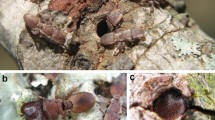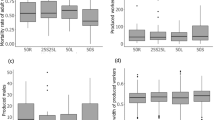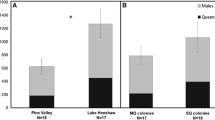Abstract
The benefit of group living is a fundamental question in social evolution. For sociality to evolve, each individual must gain in terms of some fitness component by living in larger groups. However, in social insects, a decrease in per capita success in brood production has been observed in larger groups. While it has been proposed that this decrease could be outweighed by an increase in the predictability of success, a functional basis to this hypothesis has so far never been demonstrated. In this paper, using foraging economics as a functional proxy to colony productivity, we construct a model to explore how number of foragers in the colony interacts with the ecology of resources to influence per capita foraging success and its predictability. The results of the model show that there is no increase in per capita foraging success in larger colonies under most circumstances, though there is an increase in its predictability. We then test the model with empirical data on the foraging behavior of the primitively eusocial wasp, Ropalidia marginata. The consistency between the data and the model suggests that foraging economics could provide a robust functional basis in explaining the relationship between colony size and productivity.




Similar content being viewed by others
References
Armstrong TR, Stamp NE (2003) Effects of prey quantity on predatory wasps (Polistes dominulus) when patch quality differs. Behav Ecol Sociobiol 54:310–319
Baum WM (1987) Random and systematic foraging, experimental studies on depletion, and schedules of reinforcement. In: Kamil AC, Krebs JR, Pulliam RH (eds) Foraging behavior. Plenum, New York, pp 587–607
Beekman M, Sumpter DJT, Seraphides N, Ratnieks FLW (2004) Comparing foraging behaviour of small and large honey bee colonies by decoding waggle dances made by foragers. Funct Ecol 18:829–835
Bodenheimer FS (1937) Population problems of social insects. Biol Rev Camb Philos Soc 12:393–430
Clouse R (2001) Some effects of group size on the output of beginning nests of Mischocyttarus mexicanus (Hymenoptera: Vespidae). Fla Entomol 84:418–425
Duffy JE, Morrison CL, Macdonald KS (2002) Colony defense and behavioral differentiations in the eusocial shrimp Synalpheus regalis. Behav Ecol Sociobiol 51:488–495
Harkness RD, Maroudas NG (1985) Central place foraging by an ant (Cataglyphis bicolor Fab.): a model of searching. Anim Behav 33:916–928
Jeanne RL, Nordheim EV (1996) Productivity in a social wasp: per capita output increases with swarm size. Behav Ecol 7:43–48
Karsai I, Wenzel JW (2000) Organization and regulation of nest construction behavior in Metapolybia wasps. J Insect Behav 13:111–140
Michener CD (1964) Reproductive efficiency in relation to colony size in hymenopterous societies. Insectes Soc 4:317–342
Naug D (2001) Ergonomic mechanisms for handling variable amounts of work in colonies of the wasp Ropalidia marginata. Ethology 107:1115–1123
Naug D, Gadagkar R (1998) The role of age in temporal polyethism in a primitively eusocial wasp. Behav Ecol Sociobiol 42:37–47
Reid BL, MacDonald JF, Ross DR (1995) Foraging and spatial dispersion in protein-scavenging workers of Vespula germanica and V. maculiformes (Hymenoptera: Vespidae). J Insect Behav 8:315–330
Richter MR (2000) Social wasp (Hymenoptera: Vespidae) foraging behavior. Annu Rev Entomol 45:121–150
Soucy SL, Giray T, Roubik DW (2003) Solitary and group nesting in the orchid bee Euglossa hyacintha (Hymenoptera, Apidae). Insectes Soc 50:248–255
Wenzel JW, Pickering J (1991) Cooperative foraging, productivity, and the central limit theorem. Proc Natl Acad Sci USA 88:36–38
Ydenberg RC, Giraldeau LA, Kramer DL (1986) Interference competition, payoff asymmetries, and the social relationships of central place foragers. Theor Popul Biol 30:26–44
Acknowledgements
We would like to thank H.S. Arathi and two anonymous referees for numerous critical comments that helped the clarity of the ideas expressed here.
Author information
Authors and Affiliations
Corresponding author
Additional information
Communicated by L. Keller
Rights and permissions
About this article
Cite this article
Naug, D., Wenzel, J. Constraints on foraging success due to resource ecology limit colony productivity in social insects. Behav Ecol Sociobiol 60, 62–68 (2006). https://doi.org/10.1007/s00265-005-0141-5
Received:
Revised:
Accepted:
Published:
Issue Date:
DOI: https://doi.org/10.1007/s00265-005-0141-5




